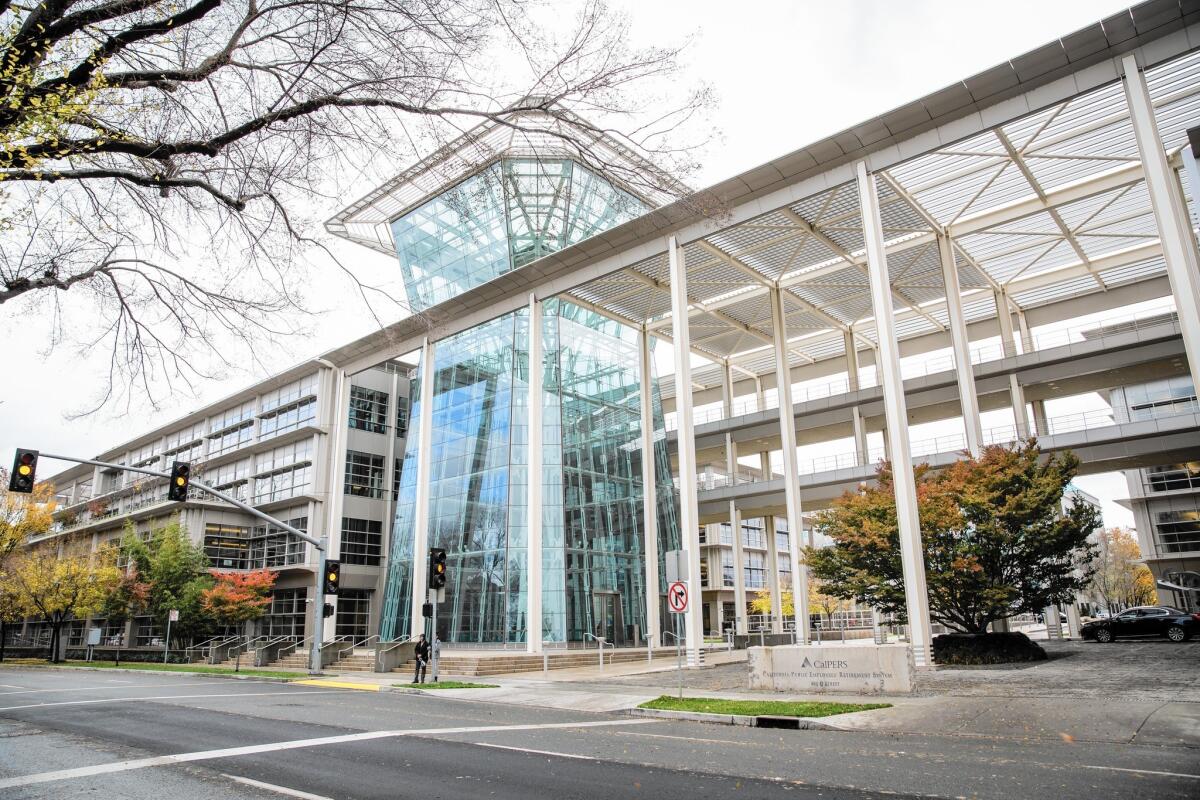CalPERS may lower its return target; taxpayers may have to contribute more

The pension fund has already warned cities that they are in the midst of a six-year span in which pension payments will rise 50%. The new plan will add even more to those costs. Above, CalPERS offices in Sacramento.
Experts have warned for years that the state’s largest public pension plan has overestimated how much its investments will earn, leaving taxpayers to pay billions of dollars more than expected.
Now the board of the California Public Employees’ Retirement System is reconsidering. As soon as Wednesday, the fund’s board could approve a plan that would slowly reduce to 6.5% the current 7.5% it says it expects to earn on its investments.
For taxpayers, that seemingly small change is significant.
SIGN UP for the free California Inc. business newsletter >>
Consider the average California Highway Patrol officer who now earns $105,000. Taxpayers currently contribute $47,000 a year for that officer’s pension.
If calculated using an expected investment return of 6.5% instead, according to CalPERS documents, the taxpayer contribution would be $68,000 — an increase of more than 40%.
“It has understated pension debt dramatically,” said Joe Nation, a professor at Stanford’s Institute for Economic Policy Research, of CalPERS’ current estimate. “They’ve been able to convince a lot of people things are OK when they aren’t.”
Nothing will happen immediately. The pension agency’s staff says it has designed the plan to soften the blow.
If the board approves the plan as expected, payment calculations won’t change significantly for years, the staff says.
Under the proposal, the rate would be reduced slowly by tiny increments. Getting to 6.5% could take 20 years.
Many experts believe that even the 6.5% estimate is too optimistic.
The average corporate pension plan now uses a rate of 4% to determine how much money needs to be contributed, according to a recent study by Milliman, a consulting firm.
This year, after several years of double-digit returns, CalPERS earned just 2.4%.
A move by CalPERS, the nation’s largest retirement fund, could lead to similar changes by government plans across the country.
CalPERS covers 1.7 million employees and retirees of the state government as well as those of cities and other agencies across California.
Nation, a former Democratic state legislator, praised CalPERS for beginning to lower the rate.
He said that by overestimating expected investment returns, CalPERS and other pension funds have hidden the true cost of public worker retirements.
Currently CalPERS says it is short about $117 billion for pensions already owed to government employees. That debt was calculated by assuming it would earn an average of 7.5% on its investments for decades into the future.
That hole would deepen more than 50% to $178 billion if the rate of 6.5% was used instead, according to Nation’s calculations.
Looked at in another way, the debt for pensions already owed to workers would rise from more than $9,000 for each California household to $14,000.
Cheryl Eason, CalPERS chief financial officer, said the fund has no intention of seeing the liability rise to that level. CalPERS has already announced other increases to the amounts governments must pay for pensions with the goal of reducing the debt to zero, she said.
Contributing to the shortfalls is a large hike in pension benefits that state legislators voted to give public workers in 1999 when the stock market was booming.
CalPERS lobbied for those more lucrative benefits. In a brochure, the fund quoted its then-president, William Crist, saying the pension-boosting legislation was “a special opportunity to restore equity among CalPERS members without it costing a dime of additional taxpayer money.”
Under those increased benefits, a highway patrol officer could retire at 50. He was promised 3% of his highest salary for every year on the job, with a maximum of 90%.
Already many California cities have been forced to cut services ranging from police patrols to library hours to cover fast-rising payments to CalPERS. Skyrocketing retirement costs were at least partly to blame for the bankruptcy filings of three California cities in recent years, including Stockton and San Bernardino.
The cuts to government services to pay CalPERS may have just begun. The pension fund has already warned cities that they are in the midst of a six-year span in which pension payments will rise 50%. The new plan will add even more to those costs.
“This is going to be pretty tough for a lot of cities,” said Rudy Fischer, a council member in Pacific Grove, where pension costs are expected to soon consume as much as 30% of the general fund — up from 20% today. “We aren’t able to do the sidewalk repairs and fix the street lights as much as we want to.”
The quiet seaside community of 15,000 is now considering allowing developers to build at least one new hotel to help raise the money needed to pay its pension bills.
In a slide presentation to the board in May, CalPERS staff estimated that taxpayer rates for pensions would rise an additional 6% to 20% over the next decades under the plan.
To make the change easier for cities, the incremental rate reductions would only be made in years of superior investment returns when governments’ finances should be stronger.
Public employees hired in 2013 or later must also pay more for their pensions under the plan. But the vast majority of employees are exempt from any increase in their personal contributions.
CalPERS staff said they proposed the plan to reduce the risk of a devastating financial loss if the stock market plunges again. It requires the fund to slowly begin moving more money into safer investments such as bonds, which earn lower returns than stocks.
Nation said the exaggerated expected investment returns have allowed governments to promise workers pensions at levels that aren’t sustainable.
“The public pension system model is all about pushing costs to the future,” Nation said. “No one has been paying attention. Now it’s caught up with them.”
Twitter: @melodypetersen
ALSO
California is steering the automobile industry toward its future
SeaWorld hopes to reverse sagging fortunes by building own San Diego hotel
Sony Pictures’ CEO talks about life a year after the hack, cyber-security, and moving on
More to Read
Inside the business of entertainment
The Wide Shot brings you news, analysis and insights on everything from streaming wars to production — and what it all means for the future.
You may occasionally receive promotional content from the Los Angeles Times.











